“Jeon” refers to the types of Korean pancakes that are battered and fried. Though there are only a handful of selections that you may find in Korean grocery stores, the world of Korean pancakes expands much broader than that.
I can’t wait to introduce you to some of the most popular Korean pancakes. There is deep culture and history embedded in these delicious Korean foods. From sweet to savory, you can eat these pancakes as an appetizer, main course, and desserts.
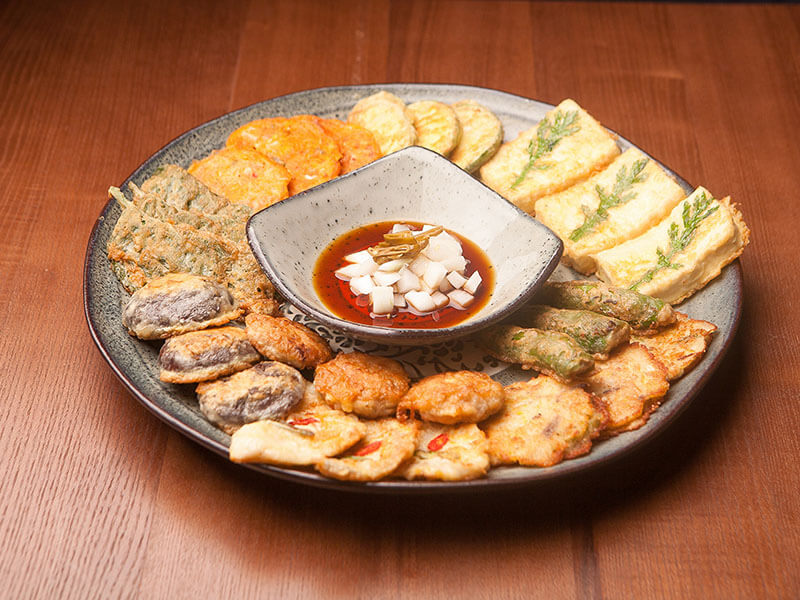
These Korean Pancakes Will Satisfy Your Sweet Tooth
Let’s kick things off with some traditionally sweet Korean pancakes. Though the dough themselves are not sugary sweet, they pair remarkably well with sweet and nutty fillings. The sweet red bean paste and nutty fillings will leave you with a good impression.
1. Hotteok: Filled Pancake (호떡)
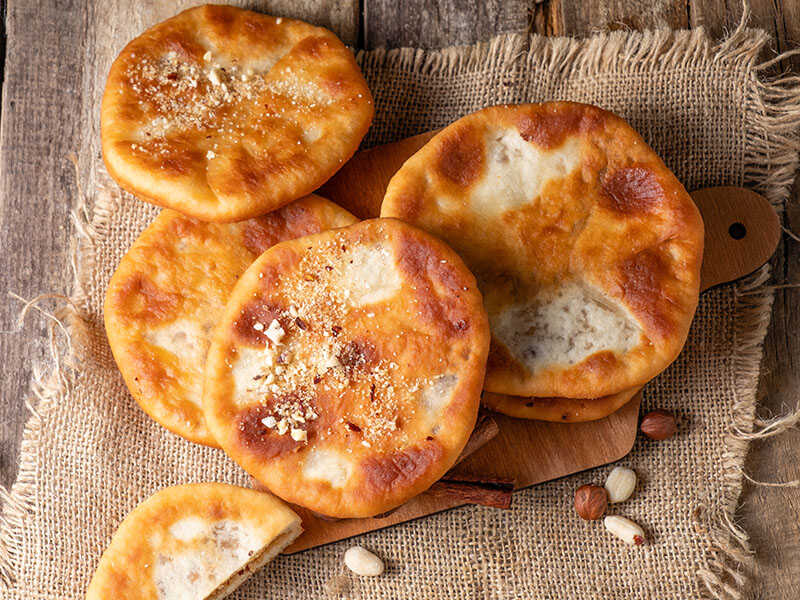
On a cold day, walking down the streets of Korea, you will indeed be enchanted by the allure of Hotteok. This pastry is a traditional Korean dessert prepared by stuffing a piece of dough with some sweet cinnamon sugar and nuts and then frying until the pastry is golden and fragrant.
There is a strong belief that Chinese merchants brought the earliest versions of Hotteok to Korea in the late 19th century. The Korean version differs from the Chinese version in the filling. Where the Chinese prefer savory meat filling, Koreans opt for brown sugar, spices, and nuts.
The method of preparation for the dough is pretty simple. You need flour, sugar, and milk for flavoring and yeast. A vendor’s trick is making the pastry soft by letting the dough rest until all the gluten is relaxed.
The filling inside was historically just brown sugar, cinnamon, and peanuts. Modern takes on Hotteok prompt the creative decisions of adding green tea, corn, and Bokbunja (a popular Korean fruit). I’m sure you will have difficulty deciding which one to eat because they are all delicious.
2. Hwajeon: Sweet Rice Pancake (화전)

Hwajeon, or Korean flower pancakes, are things of beauty. Korean people make Hwajeon during the holiday of Buddha’s Birthday and Key Holiday by pressing edible flower petals onto petit rice cakes.
Though there are many versions of Hwajeon using different flowers, the rice cakes stay the same. They are quite handy as a beautiful option for sweet breakfast recipes.
To make the rice cake, you just need to knead glutinous rice flour with honey until it is smooth. Roll out the dough and cut it into circular shapes like medallions that fit into the palm of your hand. Then, before you fry the rice cakes in sesame oil, press the flowers onto the cakes.
The cooked rice cake is sometimes soaked in honey to increase sweetness and sprinkled with cinnamon as a garnish. Korean people even make a tradition out of making Hwajeon and go on a picnic to watch spring flowers bloom called “Hwajeon-Nori.”
There is so much to learn about Korean customs through Hwajeon.
These Korean Pancakes Are Perfect Vegetarian-friendly Treats
Don’t you hate that sometimes when you decide to dine out at some Korean restaurants, but they don’t have a lot of vegetarian options available? These Korean pancakes will surely put you at ease with their exclusion of meat.
3. Hobakjeon: Zucchini Pancakes (호박전)

The term “hobak” means squash or, in this case, zucchini, so Hobak-jeon translates to “zucchini pancakes”. But instead of a standard pancake, hobakjeon consists of battered and fried zucchini pieces. It makes a wonderful zucchini-based appetizer, snack, or small plate.
There is a method of mixing your pancake batter that uses flour, water, and some seasoning. But Korean manufacturers have perfected the batter mix so well that most Koreans prefer to buy the prepackaged mix and add water.
Hobakjeon is usually enjoyed along with many other side dishes at the Korean dinner table. Korean families usually eat hobakjeon with white rice or with a soy sauce-based dipping condiment. People enjoy this dish mostly around summer, New Year’s celebration and Korean Thanksgiving.
4. Pajeon: Scallion Pancake (파전)
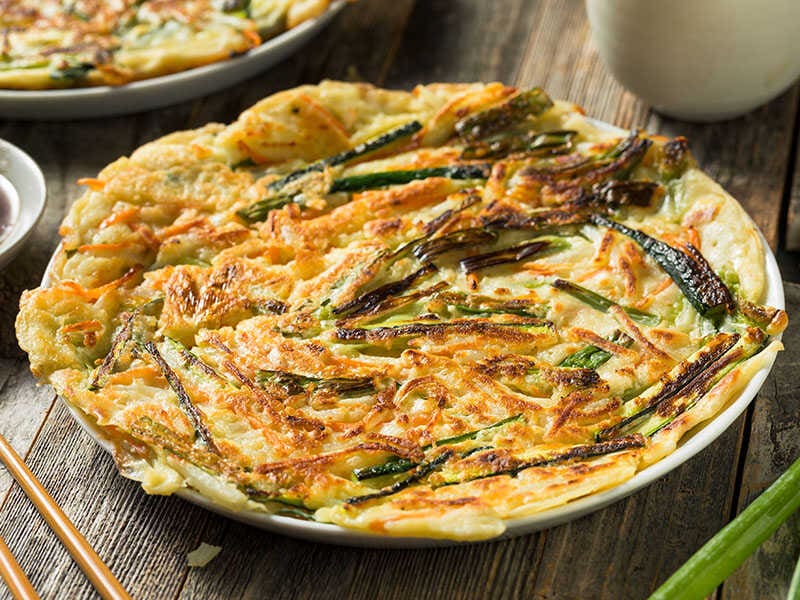
You may be familiar with the Chinese scallion pancakes. In the Chinese recipe, you need to make a yeasted dough and a slurry of fat, flour, and scallion as your filling. In Korea, people do scallion pancakes a little differently.
This Korean Pajeon does not require the cook to knead the dough until it is smooth. Instead, they will make a savory batter that has the texture of western pancake batter. Also, instead of chopping up the scallion into small pieces, Koreans prefer them the size of a matchstick.
You can eat Pajeon by itself as a snack or eat it like a side dish in a proper meal. First, you fry up a handful of fresh scallions in some oil until they start to wilt. Once the scallion softens, pour the batter on top and fry until it is golden brown and fragrant.
Pajeon is a familiar sight at most Korean dinner tables, and you can also make it at home.
5. Gamja Jeon: Potato Pancake (감자전)
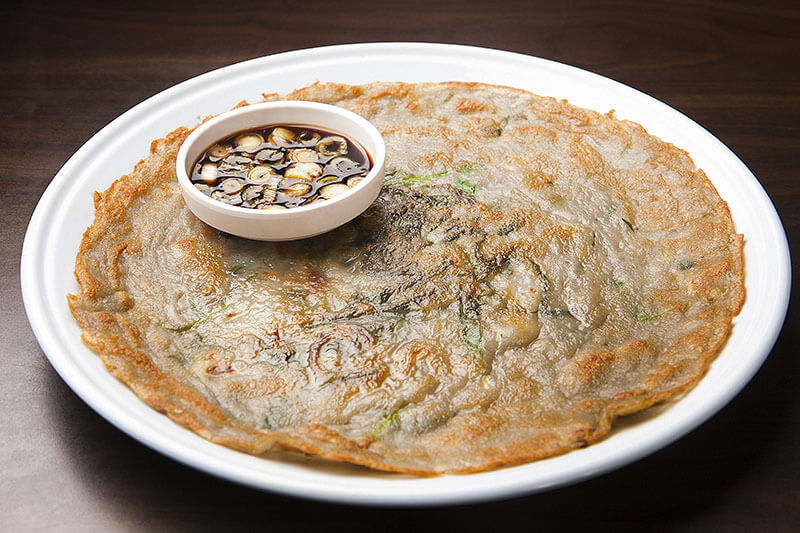
“Gamja” means potato in Korean, and “Gamja jeon” is a pancake made of pureed or grated potatoes. Gamja Jeon is much like your typical hashbrown that is so popular in the States. Where American hashbrowns have bigger potato pieces, Korean Gamja jeon require potatoes to be finely grated.
Traditionally, Gamja jeon is only prepared using potatoes, salt, and vegetable oil. Modern takes on this pancake add other crunchy vegetables, such as carrots and onions, to give the pancake a better texture. Both versions are always a reliable potato side dish to pair with your favorite food.
The grated vegetable is arranged into a circle and pressed together, so the pancake doesn’t fall apart when cooking. The fine potato patty is fried in vegetable oil until golden and crispy on both sides. Choganjang – a dipping sauce made of vinegar and soy sauce is usually the accompanying condiment.
6. Memil Jeon: Buckwheat Pancake (메밀전)
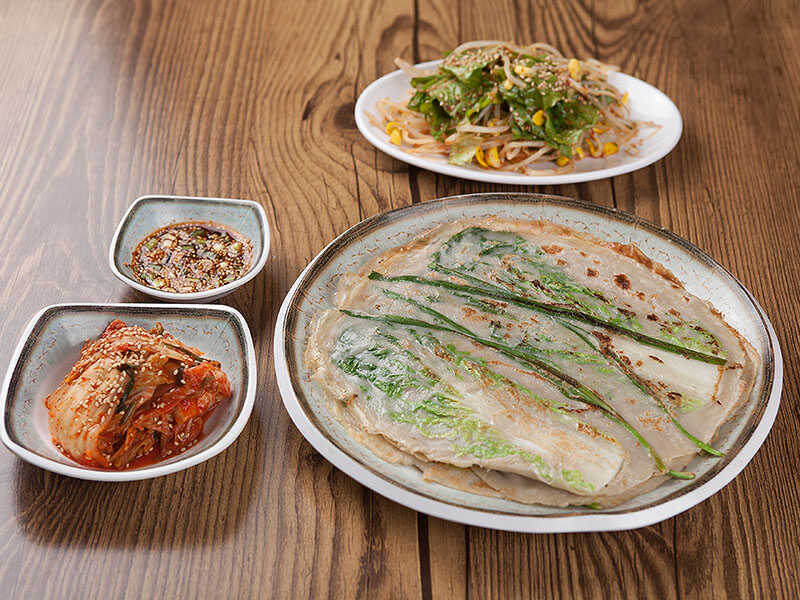
You may recognize this dish as the regional specialty of Pyeongchang, the province where the 2018 Olympics was held. Many Koreans even associated the Bongpyeong area of Pyeongchang with the buckwheat crop since most of the Korean buckwheat production came from this area.
Memil jeon batter has only two ingredients: buckwheat flour and water. Make a loose dilution of buckwheat flour until the consistency is more watery than a typical pancake batter. The trick is to get the batter as thin as possible since thick Memil jeon are unappetizing.
The topping of Memil jeon is kept relatively simple. Ripped salted cabbage or scallion is lightly fried in the pan first before pouring the batter on top, so the vegetable clings to the pancake. Kimchi is sometimes the preferred substitute for salted cabbage.
7. Buchujeon: Chives Pancake (부추전)
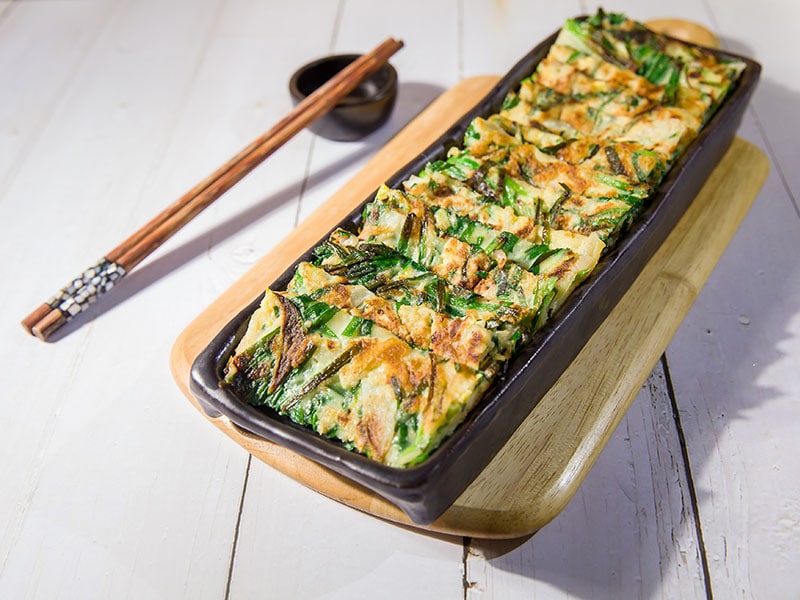
If you like the Korean scallion pancake Pajeon, you will love this Buchujeon – Korean chives pancake. Buchu-jeon is made with Garlic chives. This variety of chives differs from the typical Chinese chives you find at the store. Garlic chives are thinner and more tender.
The Buchu jeon batter is straightforward with just flour, eggs, and water. The flavoring usually depends on what you use. You can add gochujang (red pepper paste) or doenjang (fermented soybean paste). There is also the option to use just salt and pepper.
An old Korean trick to getting the Buchujeon just right is to make it so that you are left wondering if there is enough batter to cover the chive. Essentially you need to pay attention to the batter to chive ratio. You will want much more chives than batter.
8. Dubu-jeon: Tofu Pancake (두부 전)
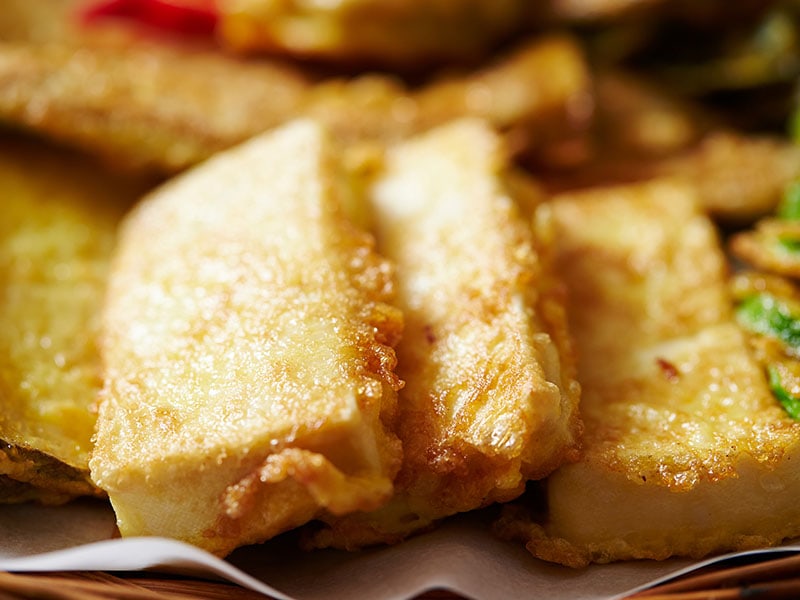
Suppose you have a block of tofu just sitting in your fridge and don’t know what to do with it. Dubu-jeon happens to be an excellent application of leftover tofu. This variation of Korean jeon is crispy, fluffy, and flavorful, which is perfect for when you want to take a break from eating meat.
Dubu-jeon comes together by crushing the blocks of tofu, mixing the bits with some vegetables, and seasoning before coating the entire thing in batter and frying. The finished products are a blend of desirable textures and flavors that are delicious on their own.
The dipping sauce for this particular pancake is made by combining soy sauce with a mixture of syrup and vinegar. The result is a tangy yet savory sauce that goes exceptionally well with Dubu-jeon.
9. Baechu-Jeon: Napa Cabbage Pancake (배추전)
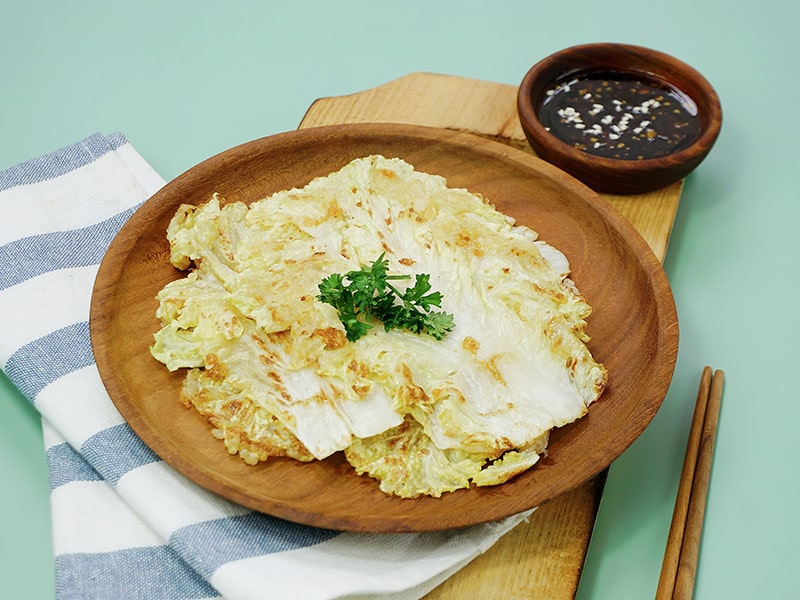
Baechu jeon uses the same kind of cabbage as Kimchi – the napa cabbage. The Gyeongsang province widely popularized this pancake that takes an entire leaf of cabbage, dredges it in an egg batter, and fries it until crispy.
Using a whole napa cabbage will not only help with the presentation of the dish, but it will keep the leaf from overcooking when frying. Coat a whole leaf of cabbage in the egg batter and fry on medium-low heat until the pancake develops a good caramelization.
The secret to a good-tasting Baechu Jeon is the batter. Substitute the water with a good anchovy stock or some Korean beer to help develop a more complex flavor profile. This pancake will also be vegan-friendly if you just leave out the egg and the anchovy broth.
Baechu Jeon is a great treat to have after making Kimchi.
10. Gaji-jeon: Eggplant Pancake (가지전)
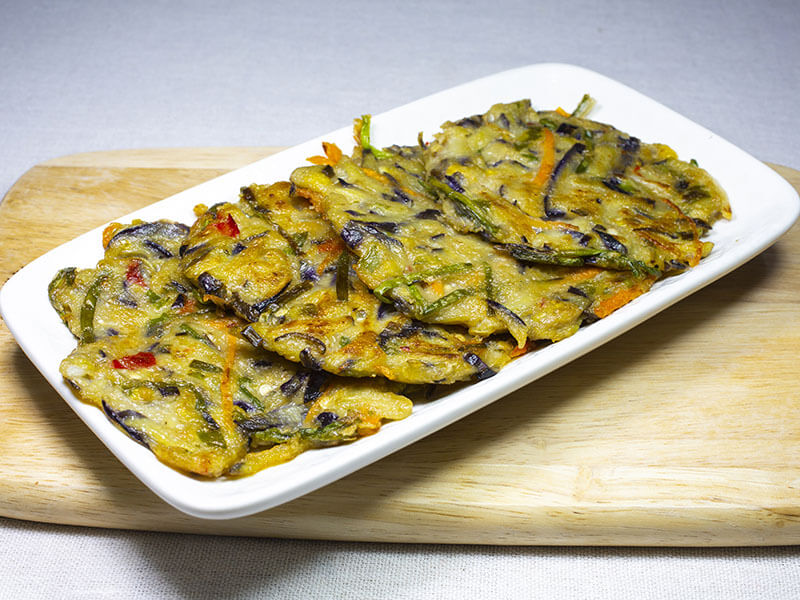
You can usually count on Korean people to make simple ingredients into a delicious side dish. Gaiji-jeon is evidence of this. You may see many similarities between this Gaji-jeon and the Hobak-jeon that I previously mentioned.
Instead of sipping the pieces of eggplant in a pancake batter like you would when making Hobak-jeon, you only need to dredge the eggplant pieces in flour and egg. Afterward, fry the eggplant in vegetable oil until golden brown and soft.
You will want to be mindful of the water content inside the eggplant. Prior to cooking, lightly toss the eggplant in some Kosher salt to draw out the moisture. The extra water will hinder the pancake from caramelizing.
Korean Pancake For Meat And Seafood Lovers Around The World
The options in this section are ideal for accompanying strong drinks, such as appetizing Korean beverages. Soft vegetables with rich pork and beef will make just about anyone happy. Of course, you can make these pancakes without the meat, but why ditch the added flavors?
11. Kkaennip Jeon: Stuffed Perilla Leaf Pancake (깻잎전)
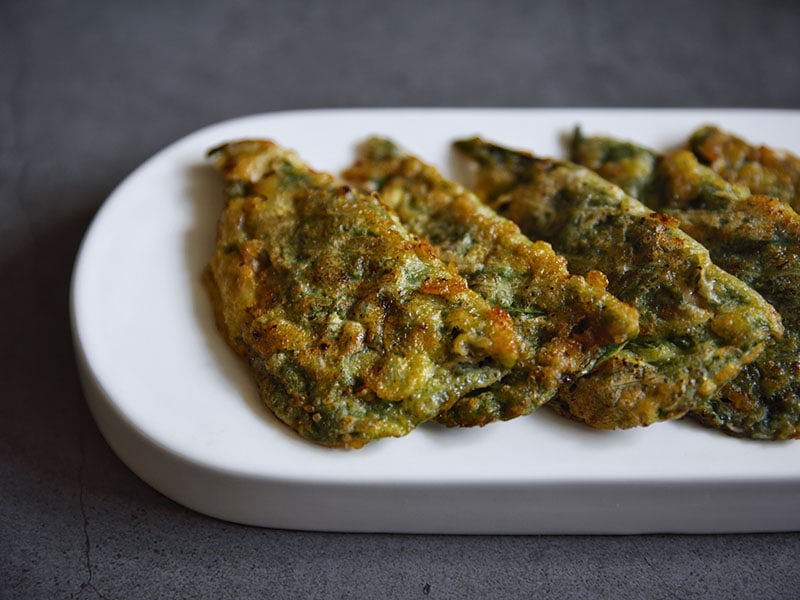
If you have familiarity with Korean BBQ, you will most likely have seen a perilla leaf. This leaf with a serrated edge has a slightly peppery and licorice flavor that is unique. Korean people love the flavor so much that there is an array of cooking dishes and condiments that include perilla.
In Kkaennip Jeon, a perilla leaf wraps around a meat and vegetable filling. This stuffed leave is then dipped in a pancake batter and fried until crispy and golden brown. Another method of making this pancake is just coating the leaf in flour and egg and frying it.
Personally, I believe the perilla leaf lends its own fragrance to this side dish but if you are not familiar with its taste, feel free to substitute the perilla with a kale leaf. You can essentially use any leaf that is a bit thicker and tougher, so it doesn’t rip when cooked.
You can definitely use Kkaenip Jeon as an appetizer, a snack, or a festive addition to the dinner table around the Chuseok holiday (Korean Autumnal Harvest Day). A great condiment to go along with this pancake is some soy sauce-inspired dipping sauce.
12. Bindae-tteok: Mung Bean Pancake (빈대떡)
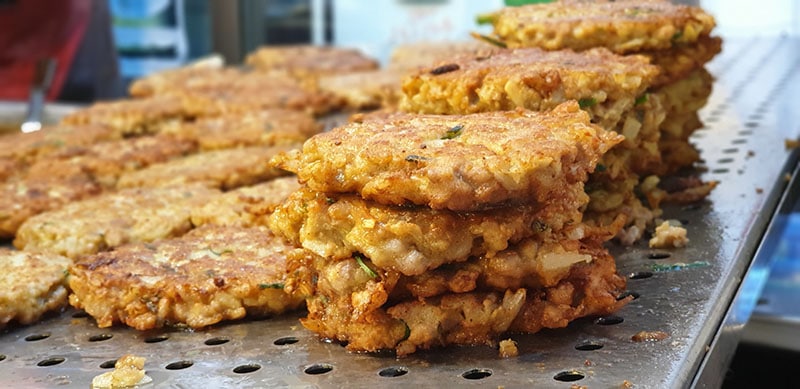
This delicious fried treat was born in Pyongan province. They soak mung beans overnight until they are soft, grind them, and fry them into flavorful pancakes. Various meats and vegetables are also added to the Bindae-tteok to impart flavor.
“Bindae-tteok” is a derivative of the middle Korean word “bingjya.” The first part of the word, pronounced “bing,” is used to describe round, pancake-shaped food and tteok, which usually means steamed, boiled, or pan-fried rice cake. In this context, it means fried pancake.
Unlike how you prepare the Hotteok, the ground-up Mung bean is not kneaded into a dough. The consistency of Bindae-tteok batter is much looser. Korean families would pour the batter into two layers and put the filling in between the layers.
You have to try Bindae-tteok the next time you visit the night markets in Korea.
13. Yukjeon: Battered Beef Pancake (육전)
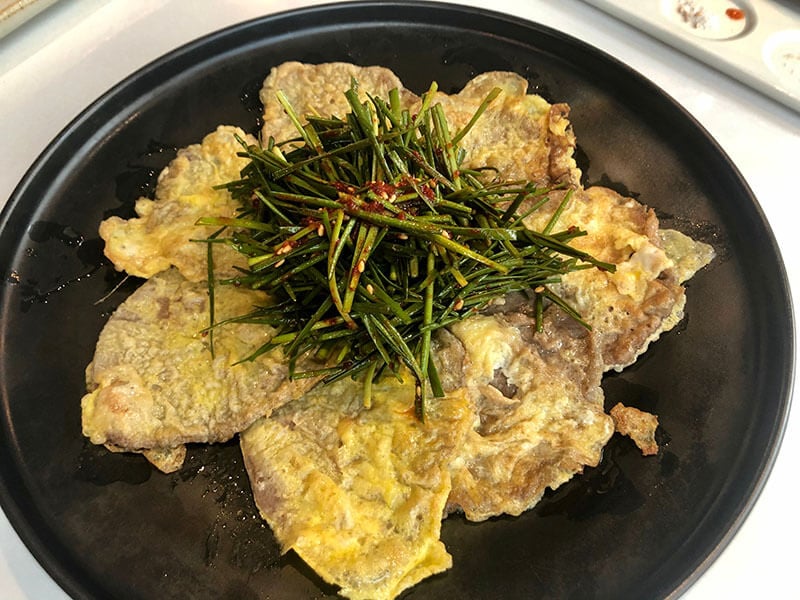
Did you know that you can make slices of beef into a type of pancake or fritter? That’s how they do it in South Korea. The term “Yukjeon” loosely translates to pan-fried beef. This side dish is usually served during a special occasion or the holidays.
Two versions of Yukjeon are popular among Korean cooks: The traditional and batterless methods. Tradition dictates that the most tender cut of beef is sliced very thinly and coated in an egg batter. The battered beef is fried on medium heat until golden and crispy.
But some foodies may prefer the non-batter version of Yukjeon because they say the flavor of the beef is more prominent without the egg. Now, instead of a pancake batter, home cooks will opt for just coating the beef in flour and frying to improve the beef flavor.
14. Kimchi-jeon: Kimchi Pancake (김치전)
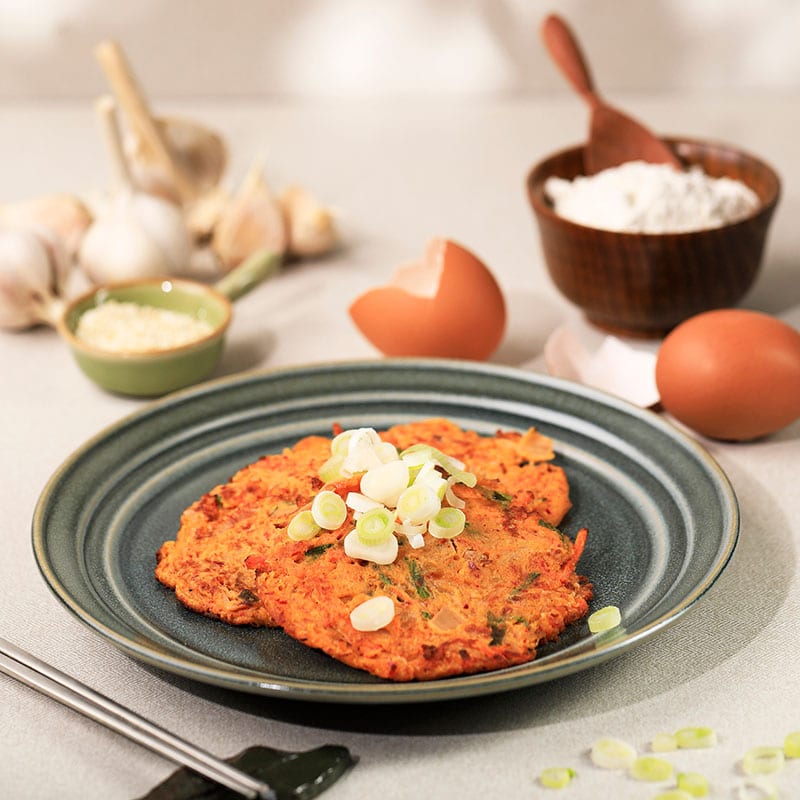
The more commonly used name for Kimchi Jeon is Kimchi-buchimgae which also means Kimchi pancake. This red-colored pancake is often served as an anju (Korean food to be eaten with alcohol) in many Korean snack bars.
The Kimchi used in the preparation of Kimchi jeon has usually passed its peak and has become a bit too sour. The fermented cabbage is cut into small pieces, and the juice is added to the batter. The Kimchi juice is full of flavor and gives the Kimchi-jeon the signature red color.
Though Kimchi jeon only requires Kimchi as the main ingredient, different variations of Kimchi jeon also exist with pork, vegetables, and cheese inclusions. Because of the low cost and its ability to use up ripened Kimchi, Kimchi-jeon is a household staple.
Kimchi Jeon is the best way to use up your old Kimchi.
15. Saeng Sun Jeon: Battered Fried White Fish (생선전)
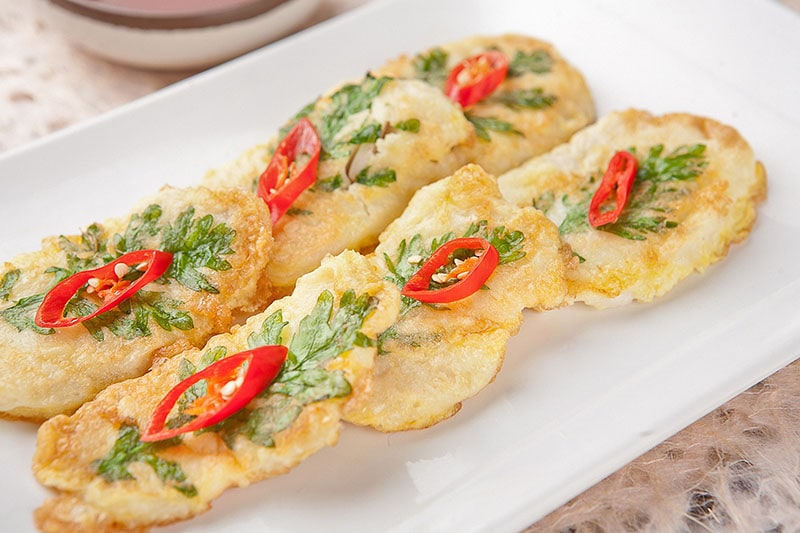
Though there are many types of fish Jeon in Korean cuisine, Saeng Sun Jeon refers specifically to the kind that includes white fishes such as cod or hake (a very long fish with a strong jaw). The white fish offers a clean taste that pairs well with the frying method.
The appropriate time to enjoy Saeng Sun Jeon is during the Korean New Year and around Chu-Seok (Korean Thanksgiving). Fresh white fish filets go through processing to become bite-sized pieces that are dredged in batter before frying until crispy.
Saeng Sun Jeon is a great option for a light breakfast or as an hors d’oeuvre for dinner parties. You can also pair Saeng Sun Jeon with other types of vegetable jeon and white rice. That is how Korean people typically enjoy this addictive fish pancake.
16. Saeujeon: Shrimp Pancake (새우전)

It is not an exaggeration to say that Korean cuisine caters to everybody, especially the art of Korean pancakes. If you are a lover of seafood, this Korean shrimp pancake bowl surely satisfies that sweet spot in your appetite.
It would help if you used Jumbo shrimp for making Saeujeon because the extra meat makes a better, fuller pancake. Of course, you can use smaller shrimps, but the bigger ones make a difference.
Before the shrimp can be battered and fried in oil, the cook would remove the shrimp’s head, shell, and gut. Then it is necessary to make a series of cuts and scorings so that the shrimp stays flat when frying. All that’s left to do is dredge and fry the shrimp in pancake batter.
17. Haemul-jeon: Seafood Pancake (해물전)
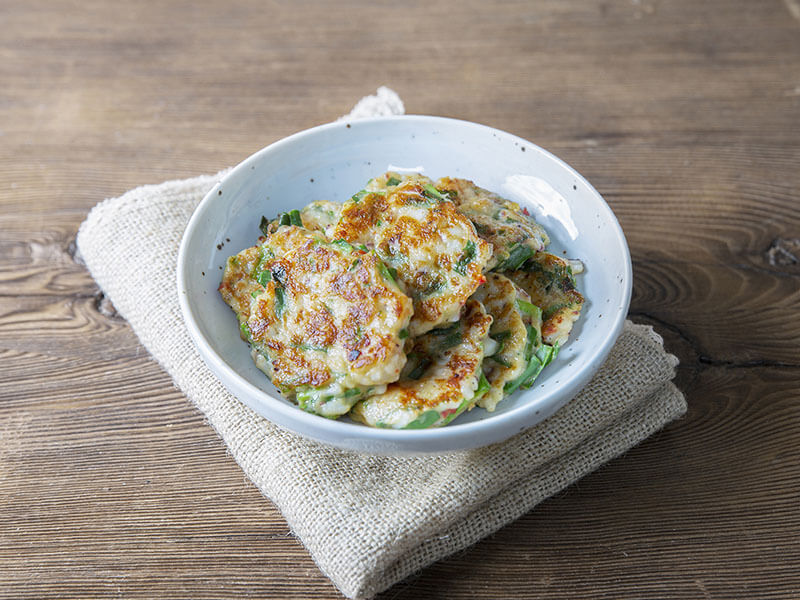
Haemul Jeon can include various fresh delicacies from the sea: shrimps, mussels, squids, etc. When it contains an ample amount of green onions, the pancake changes its name to Haemul Pajeon. Anyway, pairing this type of savory pancake with a few yummy seafood sides isn’t a bad idea.
Korean families commonly prepare Haemul jeon by using a premixed pancake mix called Buchim Garu. This saves time, especially when you need to feed an entire family in a short amount of time. But you can make the pancake batter from scratch.
The tip is to include a bit of cornstarch and rice flour into the batter to improve the crispiness. Though every family has a different spin on this delicious pancake dish, most would include some sort of vegetable to balance out the seafood.
It would be best if you always cut the seafood, such as shrimp, squids, clams, etc., into bite-sized pieces before adding them to the batter, containing flour, eggs, and scallion. Fry the cakes until golden brown, and enjoy them with vinegar and soy sauce dipping condiments.
Haemul jeon highlights the proximity of Korea to the sea by using seafood.
18. Dongtaejeon: Pollock Pancake (동태전)
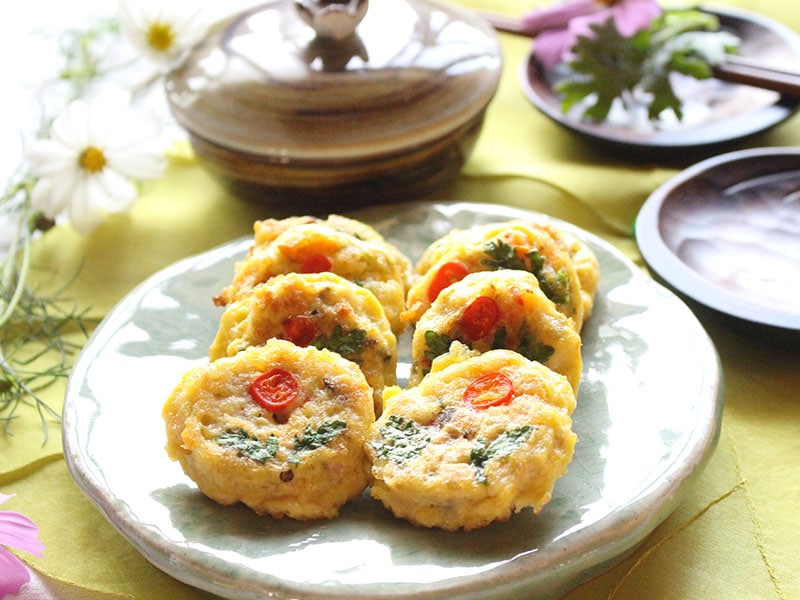
Pollock is inexpensive compared to other types of fish available in South Korea. In South Korea, pollock pancakes are usually served on special occasions alongside Bulgogi (Korean BBQ beef) and a type of famous Korean noodle called Japchae (Mixed cellophane noodle).
“Dongtae” describes the frozen pollock fish, and jeon refers to how it is prepared. Though you can make this Korean pancake with fresh pollock fish, you will often find frozen pollock more readily accessible in South Korea.
This Korean dish is great when enjoyed with a savory dipping sauce. However, you can also eat this pollock pancake with some lemon juice, alongside many other Korean side dishes and white rice.
There Is A Korean Pancake For Every Occasion
I hope this article has fulfilled your curiosity about all the different types of Korean pancakes. Even though this list is extended, I know it is far from complete. Is there a type of pancake that you recognize? Am I missing any type of pancakes?
The only way to fully know Korean pancakes is to eat Korean pancakes. And that applies to the entirety of Korean Foods. If you are tempted to try these Korean delicacies, leave a comment and share with others to spread the love. See you next time.
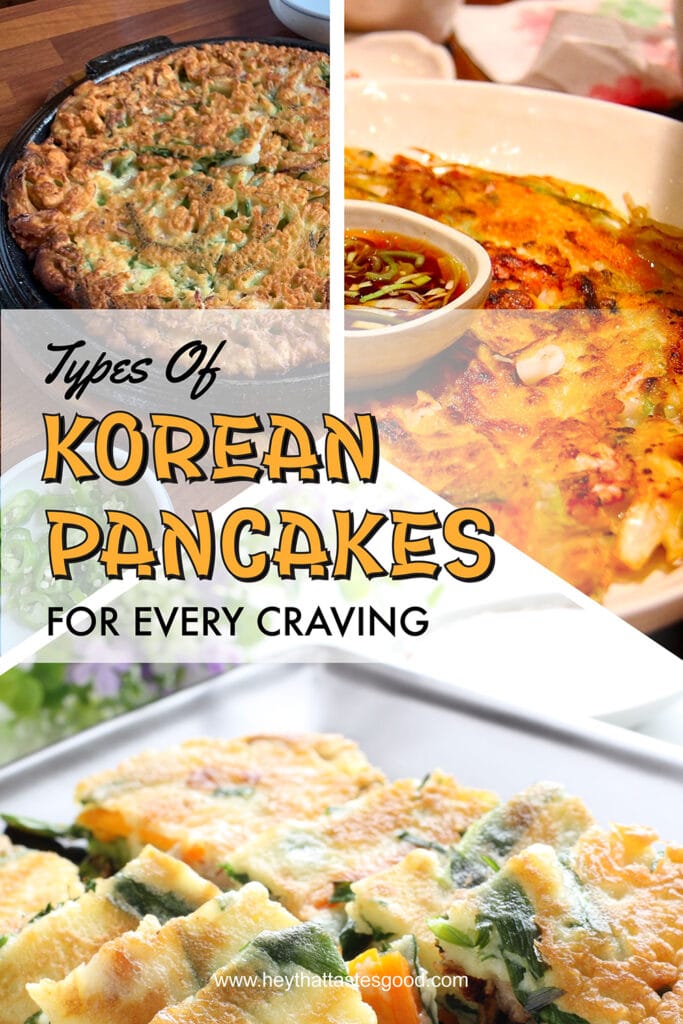


Linda Dean
Expertise
Culinary Arts, Food Journalism, Global Cuisine, Exploration, Recipe Development, Cultural Food Studies, Culinary Travel and Storytelling
Education
Culinary Institute of America, Hyde Park, NY
Program: Associate in Culinary Arts
Focus: Developed a comprehensive understanding of global cuisines and essential cooking techniques. Engaged in intensive hands-on practice in both kitchens and real-world settings, guided by expert chefs. This program emphasized the application of culinary skills in professional environments, preparing students for a variety of roles in the culinary industry.
City, University of London, London, UK
Program: BA Journalism
Focus: Gained expertise in media studies with a strong foundation in reporting, editing, and communicating. While the program focuses broadly on journalism, the skills acquired apply to food journalism, including the ability to analyze and report on food culture and culinary trends effectively.
Linda Dean is an experienced chef and food writer who loves exploring flavors from around the world. Trained at the Culinary Institute of America, Linda has spent over ten years mastering the art of making dishes that truly represent different cultures. She also studied journalism at City, University of London, which helps her write engaging stories about these foods.
On heythattastesgood.com, Linda shares recipes that bring the world’s kitchens to her readers. She focuses on authentic tastes and the stories behind them, making it easy for anyone to try international cuisine at home.